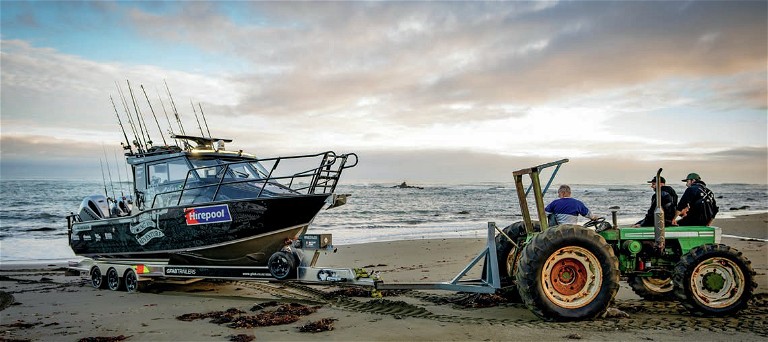Fishing & Adventure
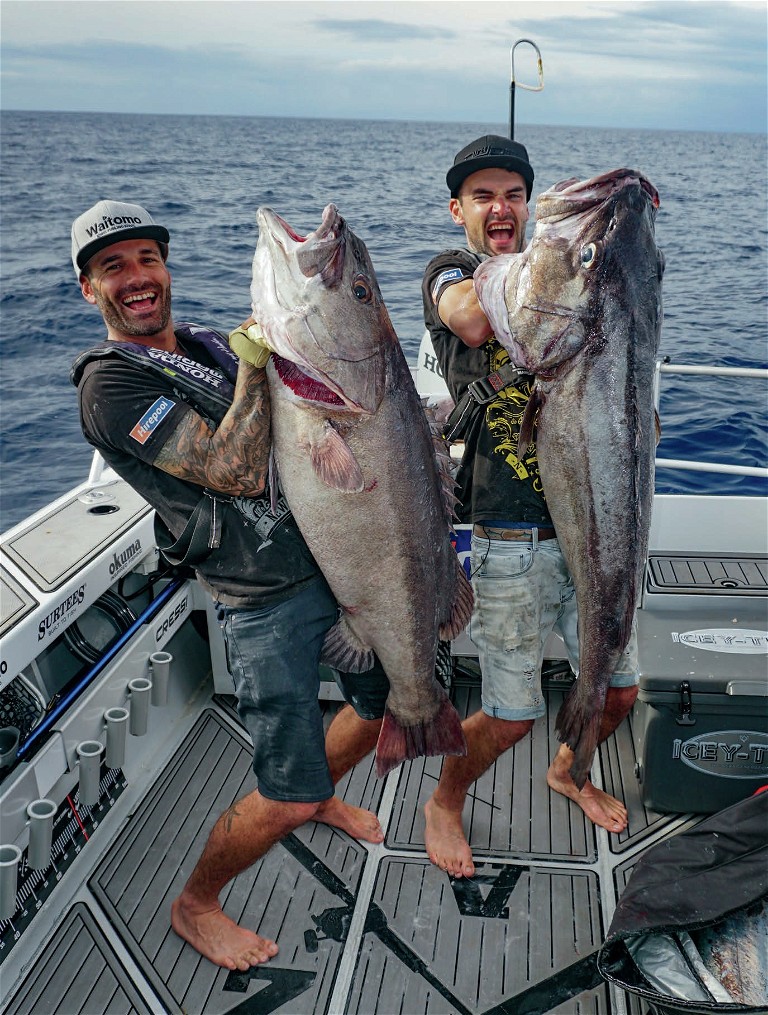

SCOTT & MIG
By Ethan Neville
Ten years ago I turned on the TV, flicked to Prime, and saw two guys in pirate costumes pulling in snapper. I won’t share my first impressions here, but it didn’t take me long to come around. These guys were genuinely funny and surprisingly willing to share their techniques and spots – and they also were catching a lot of fish. They’ve now dropped the costumes, but not much else has changed in the last decade. Scott and Mig are into their 10th season of Fishing & Adventure, and they’re just as laid back and funny as ever. I was lucky enough to spend some time with them via Zoom recently and learn about how two cousins from Hamilton managed to create the most viewed fishing show in NZ.
“It all started when Mig was 19 and I was in my late 20s,” Scott explained. “We were working together in Hamilton. Mig was from Rotorua, and I owned a business in Hamilton doing Sky installs, TV aerials, and that sort of stuff.
“We had a 5.8m aluminium boat, an old Ramco… We were doing a lot of fishing and lots of missions, to the point where work was taking a back seat so we could go fishing. We would tow the boat to a job down in Raglan, do the installs with the boat on the back in the customer’s driveway, get done early, and then shoot out for a fish.”
While work had brought the cousins back together, as Mig explained, the pair had been fishing buddies since they were kids.
“I was in Rotorua and Scott was in Raglan and Hamilton, but we had a family bach in Coromandel, so all the family would go up there on a busy weekend. We’d go out with the plan of getting a feed for the family.”
“There were lots of people and a lot of mouths to feed,” Scott continued, “so it wasn’t just about trophy fishing, it was about catching fish for food.”
By the time the cousins were working and fishing together again as adults, the angling intensity had ramped up a bit, and Scott soon realised that fishing could be more than just a hobby.
“We’d filmed a few things and put a few amateur videos together,” Scott explained, “but then I woke up one morning and thought, ‘Ya know, let’s do this.’ Mig was living with me at the time in a flat together. I got up and walked to the kitchen and said to Mig, ‘Let’s do this fishing thing. Let’s give this a proper go.’ And he said, ‘Yep, I’m in.’ And that’s how easy it was for Mig. No questions asked.”
“Yeah, I was 20 years old with nothing to lose. And the Sky installs, to be fair, were getting less and less viable as a daytime job. We would go out to Raglan and do the quintessential TV installer thing – reschedule the job, and cancel as many jobs as we could,” Mig laughed.
The next step, however, wasn’t that obvious, and they soon learnt that there’s no road map for creating a successful TV show.
“We had no experience whatsoever with making television or getting sponsorship or talking to networks,” Scott continued. “We literally knew nothing. Our background was working on the tools and doing installs. All we had was a viable concept for a television show. We saw there was a gap in the market for something a bit younger and fresher. And we obviously had a bit of a plan for what the show might look like.”
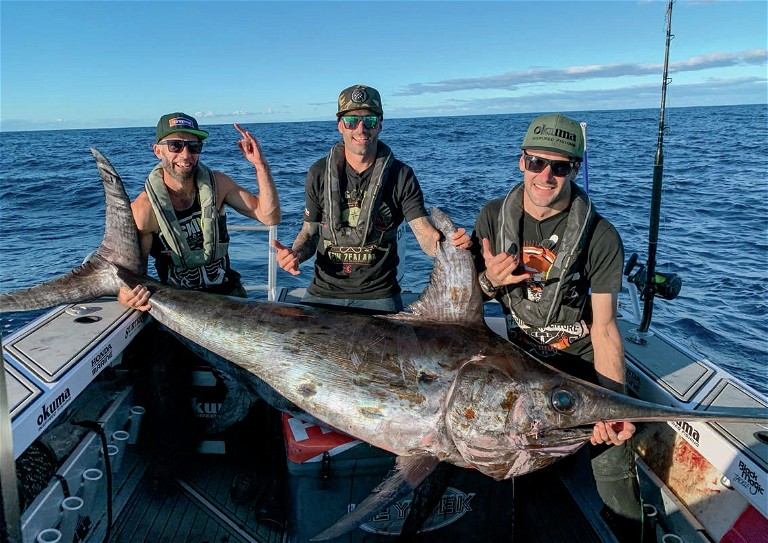
Scott and Mig’s first-ever sword was caught while filming Season 7
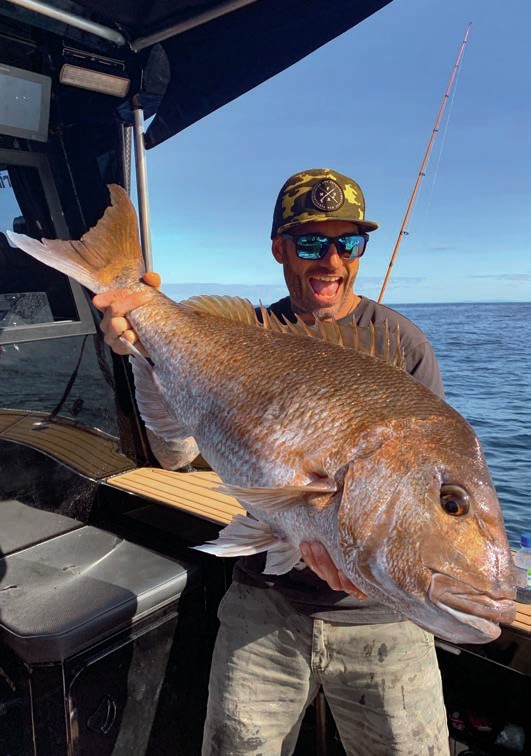
Scott with a healthy 20lb snapper.
“We had hand-cams bought from cash converters,” Mig chimed in.
“Yeah, the gear was amateur,” Scott agreed, “but the passion and the determination was there to make something happen, but it didn’t happen overnight. From there it was a pretty long process.
“You email a bunch of people, and no one responds. You ring a few people and no one gets back to you… It was challenging to just get a conversation with someone, and that was the biggest hurdle to get over. But you just keep going and keep banging on the door until someone says, ‘Yeah, we’ll have a chat.’We would have talked to over 20 production companies, and the networks didn’t want to know about it…”
Eventually, after countless phone calls and meetings, one production company agreed to give the guys a shot – but it was only then the cousins found out they needed a pilot. After wrangling together family, friends, and cheap camera gear, as well as editing software that repeatedly crashed Scott’s computer, they produced a pilot the production company liked enough to move forward with. Prime TV then said they’d take it, and it looked like the guys finally had their show. But then came the next hurdle.
“The production company said we needed $150,000 to produce the show, and that’s when we met the closed doors again,” Scott told me. “We ended up with a few thousand dollars of gear and one thousand dollars of cash from sponsors.
“The money was not coming at all and even the boat was hard to get. But as fate would have it, one of the production company’s contracted cameramen was a guy I used to skate with back in the day from Hamilton – my mate Jared – so we went and started chatting and he started coming with us on fishing missions after work. I said to him that we couldn’t get the money but asked him if he would do it.”
The answer was yes, and season one was going ahead (and for about a fifth of the production company’s quoted price). The dream had been realised, but that didn’t mean the hard work was over.
“In between filming, we did whatever work we could pick up,” Mig explained. “So, we were doing some jobs for Allied Workforce when we weren’t shooting or organising the show.
“Mig was on the side of the road picking up rubbish or breaking up concrete,” Scott continued. “I went back after the first season and continued the Sky installing business. There wasn’t any income obviously from the first season. We were able to fund that first season only because I sold the boat we had at the time... We sold the jet ski as well, and Milwaukee came on board as a sponsor, which meant we were able to basically just get by.”
By season three, Scott finally said goodbye to his Sky installing business and worked on Fishing and Adventure full time. Two seasons later, Mig joined him, and what they’d set out to do five years earlier – create a fishing show full time – had finally become a reality.
Now ten years in, they’re running a smooth ship. The business is based in Te Rapa, North Hamilton, where they have a depot filled with all their fishing gear, merch, and the newest Holy Ship. They also have staff who help with sponsorship, marketing and producing digital content, so the guys can stay focused on creating the show itself.
We’d finally come full circle back to the present, and the next question that came to my mind was the one most keen fishos would ask at this point: “So, is having a fishing show really the dream?”
“I think it is,” Scott replied immediately. “It has its moments, but when that happens, it’s very easy to think, ‘What else would we be doing? What’s the alternative?’ And then it’s a no-brainer. It’s absolutely the dream. And when you get to see the positive effect that we have as ambassadors for the brand and as personalities on different communities and especially the kids, it really hammers home why we do it.
“We’re giving them something that is super positive and which I believe is quite healthy as a hobby, particularly in the current digital world… we’re inspiring people to get out there and get amongst the outdoors, fishing, diving, and little bits of hunting – just getting out there and enjoying what’s on offer here in NZ.”
“After a long day on the water, you just want to go home to bed,” Mig continued, “but when you chat to people at the ramp you realise you can have a positive impact on people’s wellbeing, to the point where they write letters to our sponsors telling they are backing the right horse. It’s pretty epic.”
At the time of our conversation, the guys had just finished filming Season 10, which is going to air this month on TVNZ. The season features everything we’ve come to expect from Fishing and Adventure – plenty of challenges, consequences, multi-day adventures and, of course, trophy fish – but one point of difference is their new boat: the Surtees 800. According to Mig, the new Holy Ship is a boat built for catching fish.
“When it comes to fishing, the Surtees standard is bang on, because they have the double livebait tanks and the tuna tubes and everything else you need.”
“Being able to access the bow from the cockpit rather than through the cabin has been revolutionary for us,” Scott added. “The great bow rails and the ladder up the front enable us to get on and off when we’re nosing in somewhere, like onto the rocks. We used this in Fiordland to get the guys off for a hunt in ugly seas, when using a normal boat would have been almost impossible.
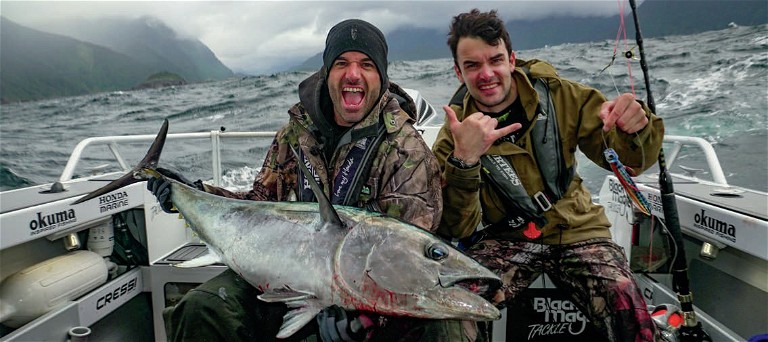
The guys pulled this southern bluefin tuna in while fishing down in Fiordland during Season 6
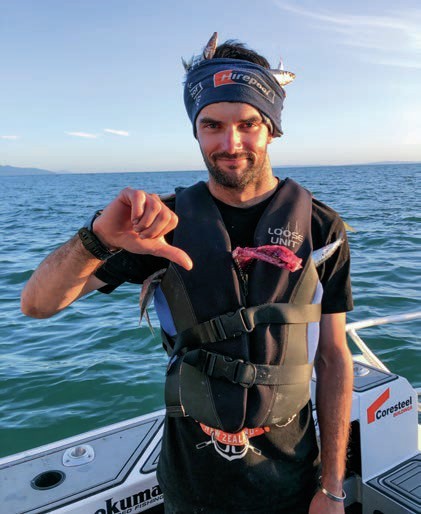
Mig seems to have suffered through the majority of the ‘consequences’ over the years.
“The 360-degree rod holders in all the gunnels are awesome. We wouldn’t be able to have a boat without them now… We also have a triple-stacked rocket launcher on the roof so we can take all our rods on the trips now and keep them out of the way.
“And I think the electronics package that Lundys have put on, the Raymarine stuff, and the C-Zone digital switching is awesome. It’s hard to go away from it now that we’ve used it.”
From the little bits of intel the guys were willing to give up, it does sound as if they have put all this gear to good use while filming Season 10. There are rumours of a bluefin tuna coming aboard the new boat, hooked in only 20m of water, as well as their first Raglan-caught 20lb snapper.
We were nearing the end of our allocated hour now, so I jumped to my final question: “What’s next?”
“We aren’t done yet,” Scott said emphatically. “There’s still plenty of gas in the tanks.”
“There are so many more locations and species that we are keen to do,” Mig chimed in. “They’ve been written on the brainstorming sheet every year, but we haven’t done them yet due to weather or scheduling. As long as we’ve got these new locations to look forward to and fresh ideas, there’ll be no slowing down.”
